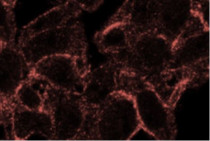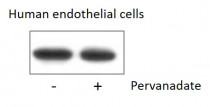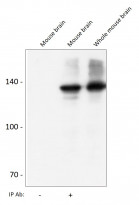ARG23870
anti-N Cadherin antibody
anti-N Cadherin antibody for ELISA,Flow cytometry,ICC/IF,IHC-Formalin-fixed paraffin-embedded sections,Immunoprecipitation,Western blot and Human,Mouse,Rat,Sheep
EMT Study antibody; Mesenchymal Markers antibody

Overview
| Product Description | Rabbit Polyclonal antibody recognizes N Cadherin |
|---|---|
| Tested Reactivity | Hu, Ms, Rat, Sheep |
| Predict Reactivity | Chimp, Chk |
| Tested Application | ELISA, FACS, ICC/IF, IHC-P, IP, WB |
| Specificity | The antibody detects a band at ~ 130 kDa in western blots of Human endothelial cells and Mouse brain tissue, and does not cross-react with E Cadherin. |
| Host | Rabbit |
| Clonality | Polyclonal |
| Isotype | IgG |
| Target Name | N Cadherin |
| Antigen Species | Human |
| Immunogen | Carrier protein coupled synthetic peptide corresponding to aa. 811-824 of Human N Cadherin. |
| Conjugation | Un-conjugated |
| Alternate Names | Neural cadherin; N-cadherin; CDw325; CDHN; CD antigen CD325; NCAD; Cadherin-2; CD325 |
Application Instructions
| Application Suggestion |
|
||||||||||||||
|---|---|---|---|---|---|---|---|---|---|---|---|---|---|---|---|
| Application Note | WB: Antibody is suggested to be diluted in 5% skimmed milk/Tris buffer with 0.04% Tween20 and incubated for 1 hour at room temperature. * The dilutions indicate recommended starting dilutions and the optimal dilutions or concentrations should be determined by the scientist. |
||||||||||||||
| Observed Size | ~ 130 kDa |
Properties
| Form | Liquid |
|---|---|
| Purification | Affinity purification with immunogen. |
| Buffer | PBS, 0.05% Sodium azide, 50% Glycerol and 1 mg/ml BSA. |
| Preservative | 0.05% Sodium azide. |
| Stabilizer | 50% Glycerol and 1 mg/ml BSA |
| Storage Instruction | For continuous use, store undiluted antibody at 2-8°C for up to a week. For long-term storage, aliquot and store at -20°C. Storage in frost free freezers is not recommended. Avoid repeated freeze/thaw cycles. Suggest spin the vial prior to opening. The antibody solution should be gently mixed before use. |
| Note | For laboratory research only, not for drug, diagnostic or other use. |
Bioinformation
| Database Links | |
|---|---|
| Gene Symbol | CDH2 |
| Gene Full Name | cadherin 2, type 1, N-cadherin (neuronal) |
| Background | N Cadherin is a classical cadherin and member of the cadherin superfamily. Alternative splicing results in multiple transcript variants, at least one of which encodes a preproprotein is proteolytically processed to generate a calcium-dependent cell adhesion molecule and glycoprotein. This protein plays a role in the establishment of left-right asymmetry, development of the nervous system and the formation of cartilage and bone. [provided by RefSeq, Nov 2015] |
| Function | N Cadherin is a calcium-dependent cell adhesion protein; preferentially mediates homotypic cell-cell adhesion by dimerization with a CDH2 chain from another cell. Cadherins may thus contribute to the sorting of heterogeneous cell types. Acts as a regulator of neural stem cells quiescence by mediating anchorage of neural stem cells to ependymocytes in the adult subependymal zone: upon cleavage by MMP24, CDH2-mediated anchorage is affected, leading to modulate neural stem cell quiescence. CDH2 may be involved in neuronal recognition mechanism. In hippocampal neurons, may regulate dendritic spine density. [UniProt] |
| Cellular Localization | Cell membrane; Single-pass type I membrane protein. Cell membrane, sarcolemma. Cell junction. Cell surface. Note=Colocalizes with TMEM65 at the intercalated disk in cardiomyocytes. Colocalizes with OBSCN at the intercalated disk and at sarcolemma in cardiomyocytes. [UniProt] |
| Highlight | Related Antibody Duos and Panels: ARG30320 EMT Marker Antibody Panel Related products: N Cadherin antibodies; N Cadherin ELISA Kits; N Cadherin Duos / Panels; Anti-Rabbit IgG secondary antibodies; Related news: New EMT antibody panel is released |
| Research Area | EMT Study antibody; Mesenchymal Markers antibody |
| Calculated MW | 100 kDa |
| PTM | Cleaved by MMP24. Ectodomain cleavage leads to the generation of a soluble 90 kDa amino-terminal soluble fragment and a 45 kDa membrane-bound carboxy-terminal fragment 1 (CTF1), which is further cleaved by gamma-secretase into a 35 kDa. Cleavage in neural stem cells by MMP24 affects CDH2-mediated anchorage of neural stem cells to ependymocytes in the adult subependymal zone, leading to modulate neural stem cell quiescence (By similarity). May be phosphorylated by OBSCN. [UniProt] |
Images (5) Click the Picture to Zoom In
-
ARG23870 anti-N Cadherin antibody WB image
Western blot: 20 µg of mouse brain stained with ARG23870 anti-N Cadherin antibody at 1:1000 dilution. (Observed MW: ~130 kDa)
-
ARG23870 anti-N Cadherin antibody ICC/IF image
Immunofluorescence: MCF7-ADR cells stained with ARG23870 anti-N Cadherin antibody.
-
ARG23870 anti-N Cadherin antibody IHC-P image
Immunohistochemistry: Formalin-fixed and paraffin-embedded human pancreatic adenocarcinoma stained with ARG23870 anti-N Cadherin antibody.
-
ARG23870 anti-N Cadherin antibody WB image
Western blot: Human endothelial cells untreated (left) or treated with Pervanadate (1 mM) for 30 min (right). The blots were stained with ARG23870 anti-N Cadherin antibody. (Observed MW: ~130 kDa)
-
ARG23870 anti-N Cadherin antibody IP image
Immunoprecipitation: Mouse brain lysate immunoprecipitated with no antibody (lane 1), ARG23870 anti-N Cadherin antibody (lane 2) and whole mouse brain lysate (lane 3). The blot was stained with anti-N Cadherin (Cytoplasmic) Mouse monoclonal antibody (lanes 1-3).
Customer's Feedback













